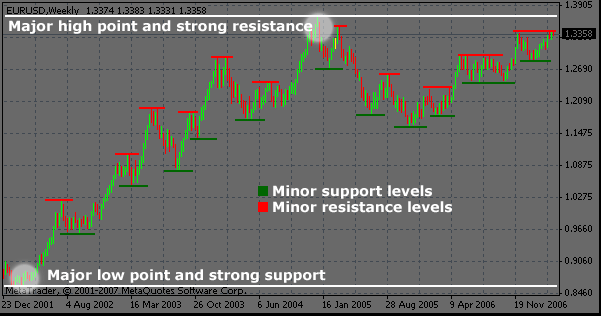How to Trade Using Support and Resistance Levels
Fundamentals of Using Support and Resistance to Make Better Trading Decisions
Trading is something we all know is a big subject, of course, anything that helps us make money is a big subject, with this not being an exception. With the vast nature of the subject matter, we need to look at an essential part of the game which can determine your success or failure known as support and resistance.
Support and resistance levels are points in time that are important. They are levels where the forces of supply and demand meet. These levels are essential for determining supply and demand as well as market psychology. When S&R levels get broken, the forces of supply and demand that created them are believed to have moved, and when this happens, new levels of S&R will appear.
Going further, let’s correctly understand the definition of support and resistance.
What is support?
Support is the point at which demand is enough to prevent the stock from falling any further. The basis is that as price drops and reaches support, demand becomes more (buyers become more inclined to buy) and supply becomes less (buyers become less willing to sell).
What is resistance?
Resistance is a level at which supply is strong enough to stock from rising any further. The basis of this is that when prices rise to the point of resistance, supply becomes more (sellers more inclined to sell) and demand less (with buyers less willing to buy).
Basically, supply is a point where the price tends to stop falling and resistance vice versa. Many would look at what has been said so far and try to make meaning of what has been said, especially on how it can help with making trade decisions and still find it difficult. Let’s move on, as there is more to learn.
Irrespective of what we know, to use S&R effectively, we need to understand how asset prices move typically so that we can interpret S&R from that context. There are also various kinds of S&R factors, such as minor and major. We expect to break lower levels, while significant levels are more likely to hold, causing the price to move in the opposite direction. We can begin making better decisions with this data provided, based on support and resistance.
So, what are the other things you need to understand when it comes to S&R and how to trade with it effectively?
Trends, Ranges and Support and Resistance
First off, S&R levels are highlighted with angled or horizontal lines known as trendlines. Once the price stalls and reverses successively on two occasions in the same price area, then you notice a horizontal line drawn there to highlight the fact that the market is struggling to move past that particular area or region.
When we talk about an Uptrend, we find prices making higher highs and on the other side, lower lows. In a downtrend, on the other hand, we find prices making lower lows and higher highs. You have to connect the highs and lows during a trend and then extend the line to the right to see where the price may find support or resistance in the imminent future.
Major and Minor Support and Resistance
Significant S&R areas are price areas that have recently caused a trend reversal. If previously a price had higher trends, and all of a sudden reverse into a downtrend, the point where the price reversal takes place is known as a strong resistance level. Also, where a downtrend ends and an uptrend begins is known as a strong support level.
Now, when the price comes back to a major area of S&R, it finds it hard to breakthrough and often moves back in the other direction. Let’s look at it this way; if a price happens to fall to a strong support level, it may bounce upwards off it. This price might later break through it, but usually, the price retreats from the level a couple of times before doing so eventually.
Minor support and resistance levels are levels we expect to get broken as we trade. If a price is on a lower trend, it will hit resistance then rebound and start to drop again. That low we talked about is known as minor support area since there was a stall in price before the bounce that took it off the level. However, since the trend is down, the price would still fall through the minor level without many problems.

With minor S&R, you have analytic insight as well as potential trading opportunities because if the price drops below the minor support level, we automatically know that the downtrend is still intact. However, if the price stalls and then bounces near the former low, then the range is probably imminent. If we have a price stall and then a bounce above the prior low, then we would definitely have a higher low, which is an indication of a possible change in trend.
Trading proper, based on support and resistance
When it comes to trading using S&R, the basic trading method is buying near support in an uptrend, chart patterns and ranges and selling or short-selling near resistance in chart patterns, ranges and downtrends.
It helps you locate and understand a long-term trend, including when trading a range or chart pattern. This acts as a guide on the direction to trade in, let’s say if the trend is down and while it is down, you find a range developing, you should focus more on short -term selling at range resistance rather than buying at range support. With the downtrend, you get to understand that going short gives you a better probability of producing a profit rather than buying. If while a trend is up, you find a triangle pattern developing, you have to favour buying in support of the triangle pattern developing.
You can profit a lot from buying near support and selling near resistance, but the only variable there is the fact that sometimes, just sometimes, support and resistance do not hold as expected. For certainty purposes, you have to wait for some sort of confirmation first that the market is still respecting that area before trading.
If you are buying near a support line, you should think of waiting for consolidation in the support area and make sure you buy the support breaks immediately above the high of that small consolidation space. When the price moves that way, we know that the price is still respecting the support area and is starting to move higher to the support region and also that the price is beginning to move higher off support. This same concept applies to selling at resistance points. Wait for consolidation near the resistance area, then enter a short trade when prices drop below the lower section of the small consolidation.
When buying, place a stop loss many cents below support, and when shorting, you have to place a stop loss many cents above the resistance. If you are waiting for consolidation, you have to place a stop loss below a consolidation when buying and selling, the stop loss should be above the consolidation.
Now, considering all we have said so far when entering a trade, you should have a target price in mind for an exit that would profit you. If you are buying near support, consider leaving before the price reaches a strong resistance level. If you are shorting at resistance, you have to exit before the price reaches strong support. You have to exit at minor S&R level. If you are buying at support in a rising trend, you have to consider selling at the top of the trade channel.
In many cases, you can extract more profit if you allow a breakout occurs, instead of selling at minor support or resistance. For example, if buying near triangle support in a bigger uptrend, you may have to hold the trade until it breaks through the triangle resistance and continues with the uptrend.
There is a perception that old support becomes new resistance and vice versa. This might not be the same every time but still works well in specific conditions.
False Breakouts
The prices of assets often move slightly more than we expect them to move. Although this does not happen all the time, when it eventually does, it is known as a False Breakout. If our analysis shows that support is at $10, it is possible that prices would drop through $10 and $9.95 and then begin to rally once again.
One thing you have to understand is that S&R are not exact prices but areas where you should expect some variability in how prices move around support and resistance. It is therefore unlikely for it to stop at the same price as before.
With false breakouts, you have excellent trading prospects, and one good approach is to wait for a false breakout and enter the market after it happens. Let’s look at it this way, if the trend is up with the price pulling back to support, let the price break below support and then buy as soon as the price starts to rally above support. Likewise, if the trend is down and the price is pulling back up to resistance, you have to wait for the price to break above resistance and short-sell immediately, the price starts to drop below resistance.
This approach has a downside because false breakouts do not always happen. Waiting for this to happen means you might likely miss good trading opportunities. With this in mind, you have to take opportunities as they come, and if you happen to catch the false breakout, make the best of it. Because false breakouts happen occasionally, this is why stop losses are placed a little away from resistance or support, so the false breakout is not likely to hit your stop loss before moving in the direction anticipated.
Adapting Your Trading Decisions to New Support and Resistance Levels
The nature of S&R means that our decisions have to be spontaneous and dynamic as well. In the event of an uptrend, the last low and last high are the most important factors. If the price takes a lower low, it shows a possible change in trend, but if the price makes a turn for a new high, that is a confirmation for the uptrend. You have to focus more on the S&R levels that matter at the moment. Trends encounter enough trouble in strong areas, they may breakthrough, but it takes multiple attempts and a lot of time.
You have to mark out major S&R levels on your chart as they could become useful in the future if the prices get to those areas. You can delete them once they become less useful, as the price breaks through strong support or resistance area and then continues to move beyond it. The level gets broken and is no longer a useful source for profit.
You also have to mark the relevant and current minor resistance and support levels on your charts to help you analyse the current ranges trends and chart patterns. These minor levels quickly lose their relevance because new minor S&R levels form often. Make sure you keep drawing new support and resistance regions to help you make the most of the chances that come per time.
If you are trading daily, focus on the day and do not concentrate more on where support and resistance levels are from previous days. We know how important information is but trying to process too much information in the process of trading can lead to mistakes, some which can not easily be corrected. Just make sure you pay attention to the now and mark out the support and resistance for the day as they form.
Not to taunt you, the art of trading off support and resistance is a work of art which takes a lot of practice. You have to be able to work on finding trends, ranges, chart patterns, support and resistance using your demo account. As you practice, taking with stop losses and targets, you find yourself getting better by the day. Once you constantly begin to profit, with the support and resistance method, you should then and only then consider trading with real money where you can make the big bucks.
Bottom Line
Profit in any venture, including trading, is something we all want. But the knowledge to make it happen is something the majority lack, making it look like an endeavour in futility. Trading using knowledge of support and resistance highlighted in this article is a stepping stone to making the most of trading opportunities, coupled with hard work and discipline. These keys, when constantly practised using a demo account will give you an edge once you begin. And when you eventually do, you will find out that trading is more than a trial by error endeavour.



















